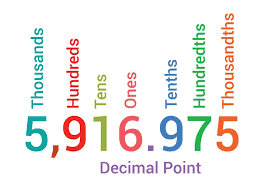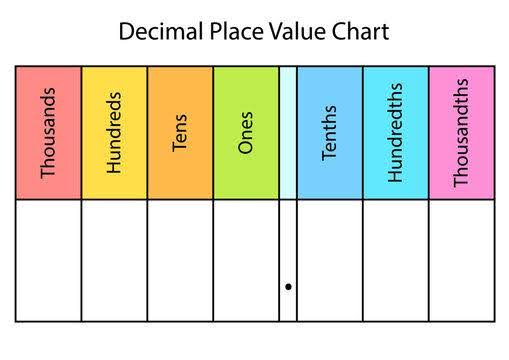
Demystifying Decimals: A Comprehensive Guide to Decimal Numbers and Their Significance
Comprehensive Definition, Description, Examples & Rules
Introduction to Decimals
Numbers are important mathematical elements that are known and classified into various types like natural numbers, rational, irrational, and more. Decimal numbers are another of the important elements to classify.
Let’s understand what is a decimal?
Decimals are numbers with a fractional part and a whole number. A dot or point present in between numbers that is a fractional part and a whole part is called a decimal point. Such as 0.8 which can be written as 08/10.
Decimal numbers are highly critical in real-life situations such as property measurements, etc. They are used in varied industries like sports, commerce, science, finance, construction, etc. In many instances where accurate measurement is required, it can result in decimal points or decimal numbers.
Understanding Decimal Numbers
Decimals definition states decimal numbers are important when it comes to accurate measurements for any number.
The decimal definition states that these numbers are a part of the whole number and the fraction part. The decimal part of a whole number works when you start with extending the place values to the right making every value on the right 10 times smaller as you place on the right side. This allows number representation that has whole numbers.
Decimal Places
Now that we know what is a decimal, we will discuss decimal places. There are different decimal places in numbers that classify differentiates:
Decimal places or place values define the positions of decimal places in numbers which determine the value. The position of the digit is important when writing specific measurements.
The various place values include
- Ones (1s)
- Tens (10s)
- Hundreds (100s)
Tens are 10 times bigger than 1s, and Hundreds are 10 times 10s. These are the main decimal points. However, place values can go left and right from the decimal point.
On the left side of the decimal point include ones, tens, hundreds, thousands, ten thousand, hundred thousand, and millions. On the right side also tenths, hundredths, thousandths, ten-thousandths, hundred-thousandths, millionths.
These values are ranked as it’s written.
For instance 456.34
- 6 is one’s decimal place.
- 5 is Ten’s decimal place.
- 4 is a hundred decimal places.
- 3 is the tenth decimal place.
- 4 is the hundredth decimal place.
The Decimal Point
The position of the decimal point determines the value of the number. Decimal definition states the decimal points separate the whole number and fraction part. Often when you divide complex numbers, the digits after the decimal increase for more accurate measurement.
How does the decimal point affect the value of a number?
The decimal point placed at different positions in a number or digit can increase or decrease its value. The values of decimals are determined or counted from the left and right sides of the point as mentioned in decimal places.
The decimal values move from right to left.
Key Concepts:
Decimals and integers are an important part of mathematics. Integers can be positive, negative, zero, or non-zero and do not have decimal places. For instance, 4, 5, 6, 7, etc., are integers.
Decimals have the whole number and fraction part, the decimal numbers can have many place values or decimal places. Such as 0.4, 56.7, 456.777, 9876.09875, etc., are decimal numbers.
Decimal representation in comparison to fractions.
Decimals separate the whole number and fraction part, they can be divided and written into fractions. The decimal to fraction and fraction to decimal can be converted easily. The methods are:
Decimal to fraction
For instance 0.65
The expanded form – 0.65 = 65x(1/100)= 65/100=¾.
Fraction to decimal
For instance, 6/7 when divided you get 0.8571428571
Creating a Visual Aid
Here is the structure of decimal numbers:
Here is the visual representation of decimal places and decimal points:
Step Up Your Math Game Today!
Free sign-up for a personalised dashboard, learning tools, and unlimited possibilities!

Key Takeaways
- Decimal numbers are an important classification in mathematics.
- They separate the whole number and fraction part by decimal point or dot.
- The decimal numbers are used for accurate measurements in mathematics.
- Decimal numbers are used in varied industries like finance, real estate, science, and more.
- Decimal numbers have various place values to determine the value of numbers.
- Decimal numbers are separated on the right and left sides with a decimal point in the center. The left side of the decimal point is the whole number part and the right of the decimal point is the fraction part.
Quiz
Question comes here
Frequently Asked Questions
A decimal point in a number is a dot or point used to separate the whole number part from the fractional part. Such as 12.0, 0.3, 67.8, 45.5, 76.5, etc.
Decimal numbers can be read and interpreted as whole numbers as whole and separately after decimal.
The decimal fractions are written in the form of p/q where p is the numerator and q is the denominator. Decimals can be written with decimal points. Fractions can be converted into decimal points and decimal points can be converted into fractions.
Often people confuse decimal places when writing about various number positions.



